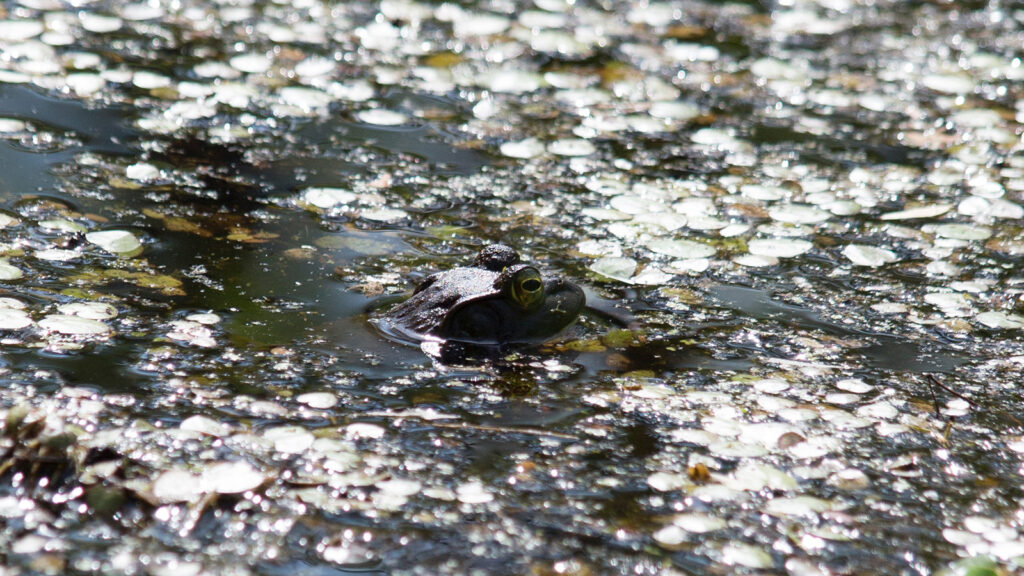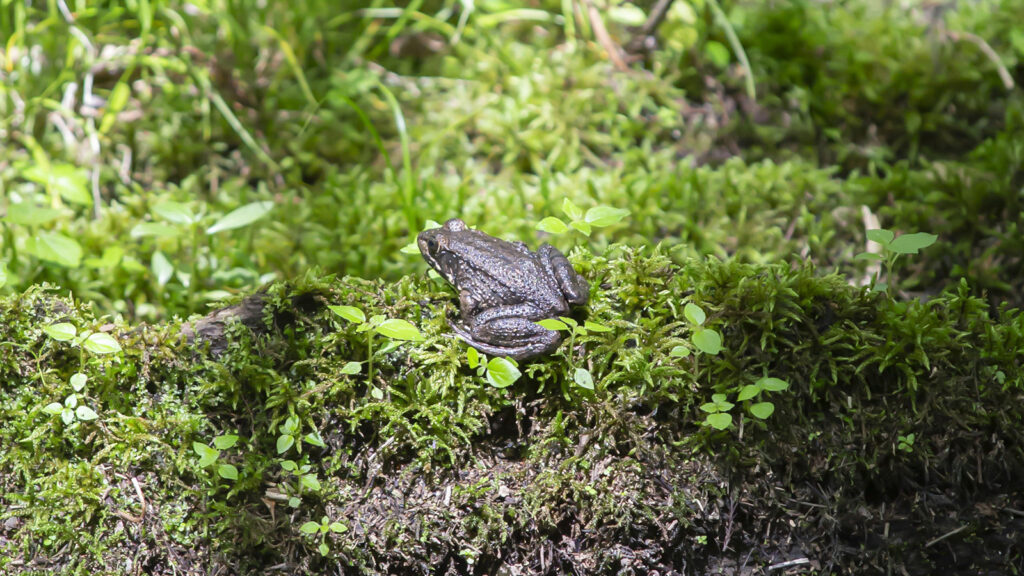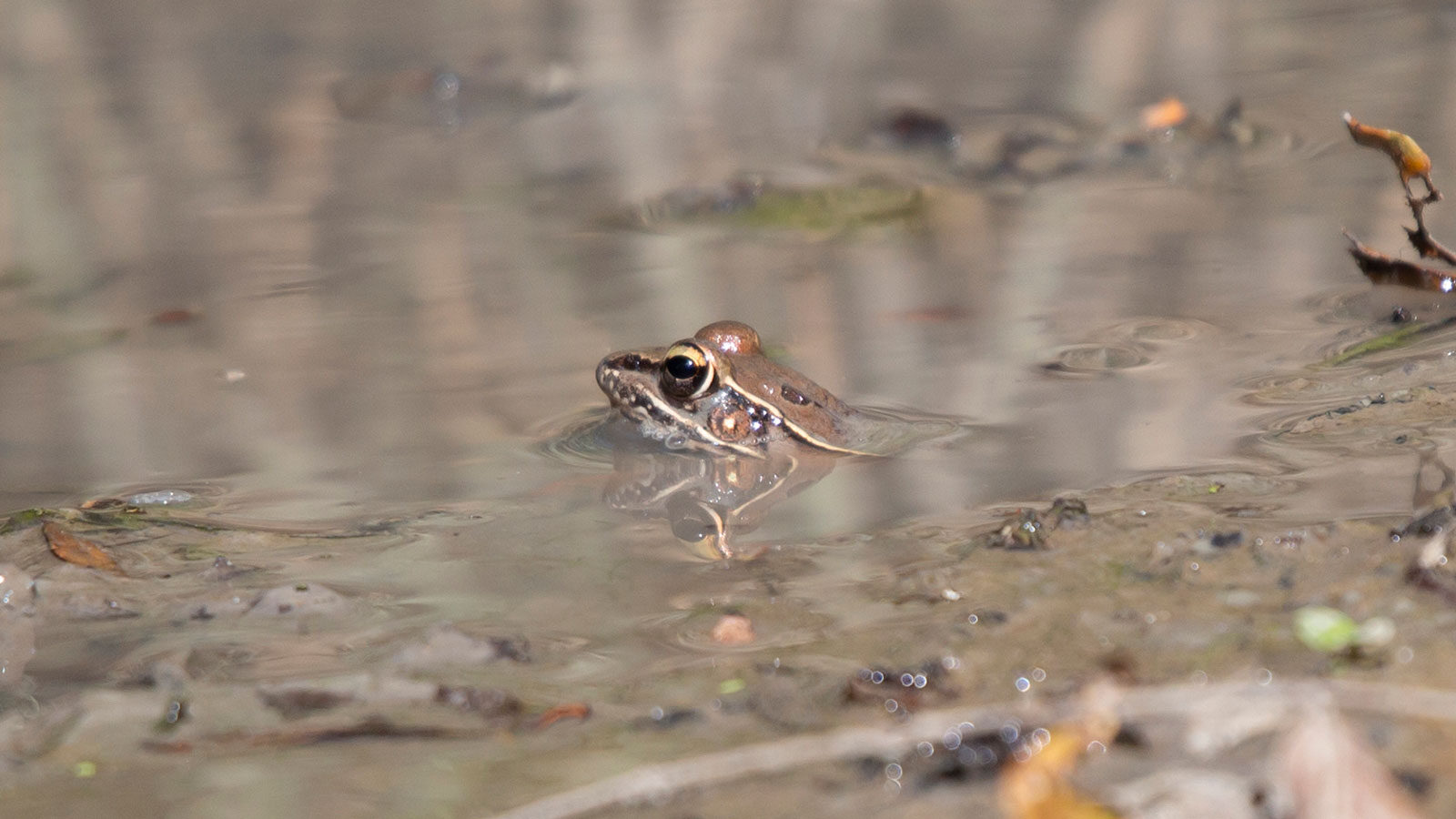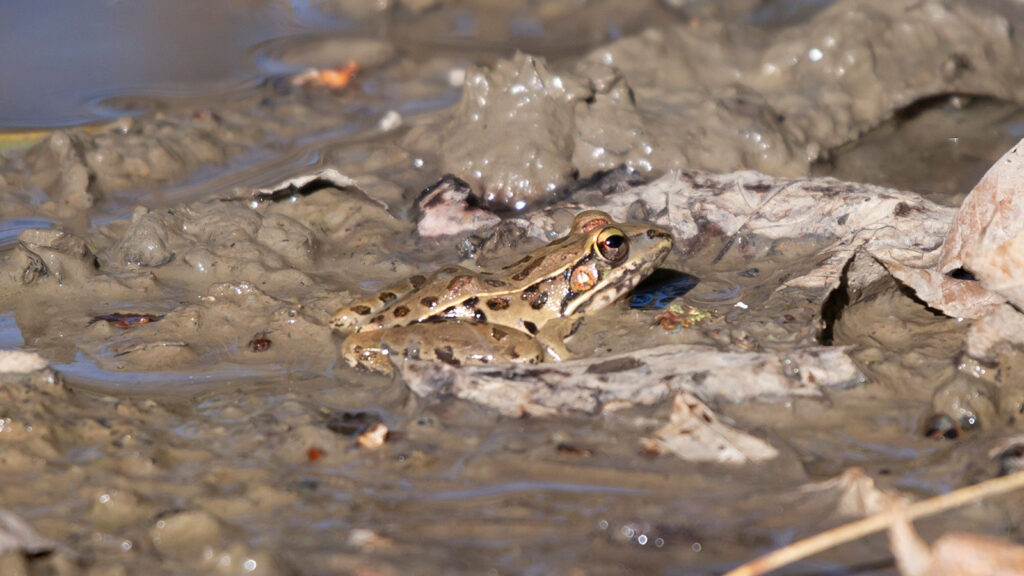Bronze Frogs
at
a Glance
Key Features:
Bronze frogs are large, green or brown frogs who live in wetlands. You can identify a bronze frog by the dorsal fold ridge that runs from the eye to the back leg.
Conservation Status: Least - Concern Population Stable
Habitat:
Ponds, lakes, swamps, forests, agricultural fields.
Breeding habits:
Bronze frogs breed from March through July and lay 4,000 to 8,000 eggs per clutch. The eggs hatch in 3 to 12 days.
seasons BrONZE FROGS are active in our area:
Spring, Summer, and Fall
Diet:
Adults eat ants, beetles, moths, and earthworms. Tadpoles eat algae, dead fish, and other tadpoles.
hunting Behavior:
Bronze frogs hide during the day and are most active at dusk and night when they hunt prey by sitting quietly and ambushing prey that ventures too close.
commonly confused with:
Other frogs and toads, especially bullfrogs and southern leopard frogs
Southern leopard frogs are often confused for bronze frogs due to their brown color and large size.
Southern leopard frogs, like this one, have black spots that differentiate them from bronze frogs.
ABOUT BRONZE FROGS
Bronze frogs are the Minoans of frogs; only instead of being Bronze Age rock stars, they’re bronze-colored country frogs. Named for their ancient fashion style, these brownish-bronze frogs are the southeastern subspecies of the green frog.
Nah. Not that green frog. These little guys and gals are related to Kermit the same way leopard frogs are related to that loveable conquistador of Manhattan. Green frog subspecies, bronze and northern green frogs, are ground dwellers, not arboreal green tree frogs.
Bronze frogs are one of two subspecies of the green frog found in the eastern U.S. and British Columbia in Canada. They and their sibling northern green frogs live in 30 states throughout the country.
As with all true frogs, bronze frogs belong to the Ranidae family of the Anura order. As we mentioned above, the bronze frog is a subspecies of the green frog. Bronze frogs, called Rana clamitans clamitans and Lithobates clamitans, hop and burrow throughout our ponds, streams, and swamps.
Bronze frogs and their sibling northern green frogs occupy nearly two-thirds of the United States. Northern green frogs roam the waters of 28 states: Alabama, Arkansas, Connecticut, Delaware, Georgia, Illinois, Indiana, Iowa, Kentucky, Massachusetts, Michigan, Minnesota, Mississippi, Missouri, New Hampshire, New Jersey, New York, North Carolina, Ohio, Oklahoma, Pennsylvania, Rhode Island, South Carolina, Tennessee, Vermont, Virginia, West Virginia, and Wisconsin. Bronze frogs live in 11 states; they cohabitate with the northern green frog in 8 of those. Louisiana, Florida, and Texas are the only states where the bronze frog lives and the northern green frog doesn’t. The bronze frog also inhabits most of Mississippi, except for the top right corner of the state; most of South Carolina; parts of Alabama, Arkansas, and Georgia; and small portions of Missouri, North Carolina, and Tennessee.
In addition to being one of only three states where the bronze frogs live, love, and leap, Louisiana is the only state to have the amphibian statewide. The most likely reasons these frogs thrive in Louisiana are the humid, bug-inviting weather and the frog-inviting waterways that cover nearly a quarter of the state. Bronze frogs hop throughout our ponds, rivers, and swamps, snapping up bugs that also love our waterways. Many times they hide in plain sight, though people often overlook them.
Contrary to the name, bronze frogs are not always brown. They are gray, green, brown, or a combination of the three. It’s not uncommon to find a bronze frog with a green or gray head and a brownish body area. Bronze frogs have white bellies covered in dark, irregular blotches, and bright green upper lips and noses. Males are often greener than females, and some males have yellowish throats. Tadpoles are similar in coloration: They’re green with black spots and yellow bellies.
In North Louisiana, bronze frogs are most often mistaken for southern leopard frogs and bullfrogs due to their size. However, these frogs are slightly smaller than leopard frogs and significantly smaller than bullfrogs. They also lack the round markings found on southern leopard frogs. You can differentiate them from bullfrogs and other frogs by their sizes and dorsal folds. Bronze frogs are smaller than bullfrogs and southern leopard frogs, and larger than cricket frogs. Adults range from two to four inches in length. Unlike bullfrogs, whose dorsal folds (ridges on both sides of the body) loop behind the eye around the eardrum area (tympanic membrane), the dorsal folds on bronze frogs run from the eye to the hind leg.
Bronze frogs are true frogs with smooth, moist skin. They’re not fake frogs like those toads that hop around with their like tragic, dry, bumpy skin. Like other true frogs, Bronze frogs have webbed feet and strong legs that send them quickly out of sight.
The bronze frog’s scientific name, Lithobates clamitans, defines it as “a loud stone,” which anybody who’s ever met one of these Minoan super frogs will likely agree with. They’re the loudest rocks in North Louisiana. Despite the widespread belief that all frogs make a clear “ribbit” or “croak” sound – seriously, cartoons have led us astray-, most frogs make other sounds. The bronze frog’s most notable call, and the one that gives it its nickname, sounds like the amphibian is plucking a banjo – a stringed instrument, not a Nintendo bear.
Male bronze frogs use more than six calls, two of which female bronze frogs also use. Males have two calls for mating, including playing the banjo. They also have calls and growls that warn other male frogs to get out of their territory. Both non-receptive females and males accidentally grabbed by males to mate will issue a release call, and all bronze frogs will send up an alert call if they’re startled or attacked by a predator. Bronze frogs most commonly use their advertisement calls in the evenings and at night, but they will use them during the day at the peak of the breeding season. Listen closely for the call; it can help you locate an otherwise camouflaged frog.
Bronze frogs are carnivores who eat mostly bugs, and their main course generally includes beetles, butterflies, caterpillars, crawfish, flies, snails, spiders, and worms. Large bronze frogs supplement their diets with smaller frogs and small snakes. Tadpoles eat diatoms, a type of protist also found in toothpaste, zooplankton, and algae. So, bronze frog tadpoles have super clean teeth and excellent dental hygiene…at least they would if it weren’t for the rest of their diet.
Froglets and adults are ambush predators who use their natural camouflage to surprise prey that comes too close. They use excellent vision to hunt in vegetation at the edge of the water.
A bronze frog’s life starts a week after its mom lays two to four thousand eggs in the shallow water of a ditch, lake, marsh, spring, or stream. The frog is born sometime between early spring and mid-summer, depending on whether it’s born as part of its mom’s first or second clutch of eggs for the season.
The bronze frog and its siblings hatch within a week and begin their lives as tadpoles. The tiny fish-like amphibians swim around the area where they were born, breathing through gills. Three to five months later, the frog and its brothers and sisters metamorphosize into froglets who begin to grow tiny legs and lungs. Within two years, it will lose its gill and tail. The frog will reach its full size at four to five years old and live another two to five years.
The frog will reach sexual maturity and participate in the first breeding season after it completes metamorphosis from tadpole to adult. The breeding season for bronze frogs in early spring through the summer.
The male bronze frog attracts mates with his banjo-like sounds. He’ll sing from selected spots within his 3 to 20 square foot breeding territory and patrol the edge of the territory for interlopers. He’s aggressive during mating season and will attack other males that wander into his territory. Sometimes he and other male frogs will aggressively call out to each other like they are spitting before fighting.
The female bronze frog selects a mate based on the location of the male’s breeding territory. Sometimes, she’ll mate with a smaller frog in the larger frog’s territory.
Outside breeding season, the bronze frog is solitary, hunting and fleeing predators alone for most of the year. The male bronze frog will establish a nonbreeding territory of 200 to 2000 square feet.
You can find bronze frogs throughout North Louisiana, especially near swamps and shallow streams. Although they spend most of their time under rotten logs, you can find them in shallow water, at the edge of the water, and on vegetation in the shallow water. You may have to look hard to find them since they tend to blend in with their muddy environments. We’ve had the best luck meeting our local bronze frogs at the Black Bayou Lake NWR and the Tensas River NWR.
While most frogs are primarily nocturnal, bronze frogs are cathemeral and active day and night. The best time of day to meet them (while you still have daylight) is late in the evening at dusk. They are primarily diurnal during the mating season in the spring and when winter days are warm enough for them to come out of brumation.
Bronze frogs are most active in the spring and early summer during the mating season. Because they camouflage to their environment so well, you’ll have the best opportunity to find them when the males play their mating call on humid evenings. Listen closely, and you’ll likely follow their call to the vegetation at the edges of swamps, ponds, creeks, and rivers, especially in wooded areas.
During the coldest winter weather, bronze frogs, like other amphibians, will go into brumation, hibernating in mud tunnels they dig in their territories. Because our winters are so warm, bronze frogs, like other animals in North Louisiana, strategically rest rather than staying in brumation all season. You can find them hopping around on many winter days, especially during those famous 60-degree Louisiana winters.
If you want to learn more about these fascinating frogs, check out the University of Michigan’s Critter Catalogue, the University of Georgia Savannah River Ecology Laboratory Herpetology Program, or The Alabama Wildlife Federation’s Wonders of Wildlife site. The Savannah River Ecology Laboratory Herpetology Program at the University of Georgia site has a full page of info about your local bronze frog, including a sound clip that highlights the banjoyness of the call.
Learn more about the decline of amphibians throughout the world at the Texas Parks and Wildlife “Bronze Frog” fact sheet.
You can check out our water ranking at the U.S. Geological Service’s “How Wet is Your State? The Water Area of Each State.” Surprisingly, Louisiana isn’t number one in this category!
Bronze Frogs v. Predators
Carnivorous bugs, like diving beetles, dragonfly larvae, fish, leeches, raccoons, and turtles eat bronze frog spawn and tadpoles. Egrets, larger frogs, hawks, herons, minks, otters, raccoons, snakes, and turtles eat adult bronze frogs. Garter snakes, eastern hognose snakes, great blue herons, red-tailed hawks, and raccoons are the biggest predators of bronze frogs in North Louisiana.
Tadpoles are helpless because they have a limited range and can’t leap away from danger. Because of the large number of predators, most tadpoles die before they complete metamorphosis into adulthood. Once they become frogs, bronze frogs depend on camouflage to blend into their surroundings and not get eaten by predators. When that doesn’t work, they urinate on themselves to make themselves taste bad to predators and inflate like balloons so that predators have trouble swallowing them.
Bronze Frogs and Humans
Bronze frogs are beneficial to humans in that they eat bugs that bug people, like spiders and flies. They also serve an essential role in their ecosystems as food for larger birds, reptiles, and mammals. Bronze frogs even serve an important role in Louisiana kitchens. Frog legs aren’t as standard a meal as they used to be, but hunters still grab these frogs for their moderate legs. While froggers most commonly hunt bullfrogs, leopard frogs, and pig frogs in Louisiana, they also snap up bronze frogs. Scientific supply chains often breed bronze frog’s green siblings for biology class cutting boards.
The high mortality rate among tadpoles and the predation of these adult frogs by humans and other animals has caused a decline in frogs and other amphibians worldwide. Amphibians have permeable skin, and pollution, habitat destruction, invasive species, and bacteria outbreaks may also contribute to the declining number of amphibians worldwide.



